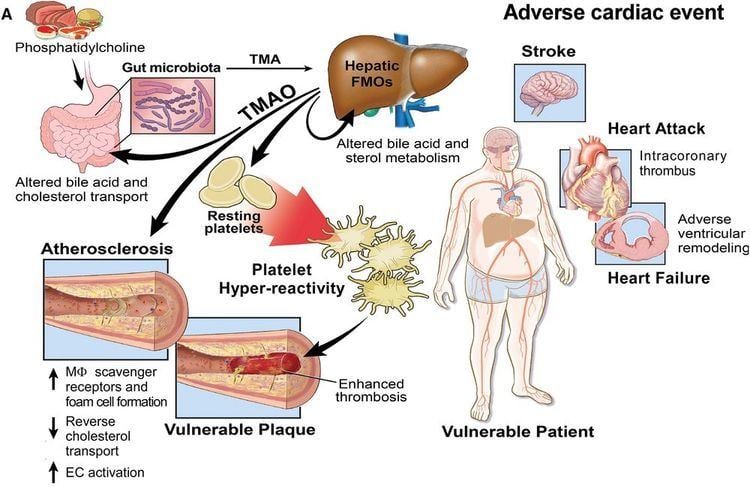Formula C3H9NO Appearance colorless solid | Molar mass 75.10966 g/mol | |
 | ||
Gut bacteria and red meat trimethylamine n oxide tmao
Trimethylamine N-oxide (TMAO) is the organic compound in the class of amine oxides with the formula (CH3)3NO. This colorless solid is usually encountered as the dihydrate. It is a product of the oxidation of trimethylamine, a common metabolite in animals. It is an osmolyte found in saltwater fish, sharks, rays, molluscs, and crustaceans. It is a protein stabilizer that may serve to counteract urea, the major osmolyte of sharks, skates and rays. It is also higher in deep-sea fishes and crustaceans, where it may counteract the protein-destabilizing effects of pressure. TMAO decomposes to trimethylamine (TMA), which is the main odorant that is characteristic of degrading seafood.
Contents
- Gut bacteria and red meat trimethylamine n oxide tmao
- Synthesis
- Trimethylaminuria
- Laboratory applications
- Microbiotic associations
- Health issues
- Inhibition
- References
Synthesis
TMAO can be synthesized from trimethylamine by treatment with hydrogen peroxide:
H2O2 + (CH3)3N → H2O + (CH3)3NOTMAO is biosynthesized from trimethylamine, which is derived from choline.
Trimethylaminuria
Trimethylaminuria is a rare defect in the production of the enzyme flavin containing monooxygenase 3 (FMO3). Those suffering from trimethylaminuria are unable to convert choline-derived trimethylamine into trimethylamine oxide. Trimethylamine then accumulates and is released in the person's sweat, urine, and breath, giving off a strong fishy odor.
Laboratory applications
Trimethylamine oxide is used in protein folding experiments to counteract the unfolding effects of urea.
In the organometallic chemistry reaction of nucleophilic abstraction, Me3NO is employed as a decarbonylation agent according to the following stoichiometry:
M(CO)n + Me3NO + L → M(CO)n-1L + Me3N + CO2This reaction is used to decomplex organic ligands from metals, e.g. from (diene)Fe(CO)3.
It is used in certain oxidation reactions, e.g. the conversion of alkyl iodides to the corresponding aldehyde.
Microbiotic associations
The order Clostridiales, the genus Ruminococcus, and the taxon Lachnospiraceae are positively associated with TMA and TMAO levels. In contrast, proportions of S24-7, an abundant family from Bacteroidetes, are inversely associated with TMA and TMAO levels.
Health issues
Studies published in 2013 indicate that high levels of TMAO in the blood are associated with an increased risk of major adverse cardiovascular events. The concentration of TMAO in the blood increases after consuming foods containing carnitine or lecithin if the bacteria that convert those substances to TMAO are present in the gut. High concentrations of carnitine are found in red meat, some energy drinks, and some dietary supplements; lecithin is found in soy, eggs, as an ingredient in processed food and is sold as a dietary supplement. Some types of normal gut bacteria (e.g. species of Acinetobacter) in the human microbiome convert dietary carnitine to TMAO. TMAO alters cholesterol metabolism in the intestines, in the liver, and in artery wall. In the presence of TMAO, there is increased deposition of cholesterol in, and decreased removal of cholesterol from, peripheral cells such as those in the artery wall.
The link between cardiovascular diseases and TMAO is disputed by other researchers. Clouatre et al. argue that choline sources and dietary L-carnitine do not contribute to a significant elevation of blood TMAO, and the main TMAO source in the diet is fish.
Another source of TMAO is dietary phosphatidylcholine, again by way of bacterial action in the gut. Phosphatidyl choline is present at high concentration in egg yolks and some meats.
It has been suggested that TMAO may be involved in the regulation of arterial blood pressure and etiology of hypertension and thrombosis (blood clots) in atherosclerotic disease.
Inhibition
Vegan and vegetarian diets appear to select against gut flora that metabolize carnitine (in favor of other gut flora more coordinated with their food supply). This apparent difference in their microbiome is associated with substantially reduced gut bacteria capable of converting carnitine to trimethylamine, which is later metabolized in the liver to TMAO.
3,3-Dimethyl-1-butanol (DMB), a structural analog of choline, inhibits microbial TMA formation in mice and in human feces, thereby reducing plasma TMAO levels after choline or carnitine supplementation. It is found in some balsamic vinegars, red wines, and some cold-pressed extra virgin olive oils and grape seed oils.
